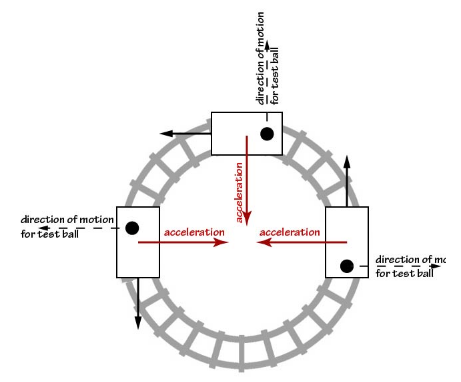 The Principles of Relativity
The Principles of Relativity
相对论原理
The Classical Principle of Relativity: The laws of mechanics are the same in all inertial reference frames.
相对论的经典原理:所有惯性参照系中力学定律是一样的。
Einstein’s Principle of Relativity: Thelaws of physics are the same in all inertial reference frames.
爱因斯坦相对论:所有惯性参照系中的物理定律是一样的。
Inertial reference frames
惯性参考系
Inertial reference frames are either atrest or they move with constant velocity with respect to each other – i.e.their speed is constant and their direction of motion is unchanged. They arecalled inertial because Newton’s principle of inertia must always hold true: anobject will move with constant velocity if there are no external forces actingon it (or the sum of the external forces is zero).
惯性参考系要么处于静止状态,要么彼此以恒定的速度移动——即它们的速度是恒定的,它们的运动方向是不变的。它们被称为惯性,因为牛顿的惯性原理必须始终成立:如果物体没有外力作用(或外力的总和为零),物体将以恒定的速度运动。
To tell if a reference frame is inertial,imagine a perfectly horizontal and frictionless surface on which we place aball at rest. If the ball starts moving (without any observable force actingupon it), our reference frame is not inertial, meaning that it must beaccelerating in the opposite direction in which the ball is moving.
判断一个参考系是惯性,想象一个完全水平和光滑的表面,我们把一个静止的球。如果球开始移动(没有任何可见的力作用于它),我们的参考帧不是惯性的,这意味着它必须在球运动的相反方向加速。
Reference frames that move with uniformspeed can still accelerate if their direction of motion is changing. Imagine atrain that is moving on a circular track. If we place a ball on a horizontalfrictionless table the ball will start moving along a direction perpendicularto the tracks.
如果运动方向改变,匀速移动的参考帧仍然可以加速。想象一辆火车在环形轨道上行驶。如果我们把一个球在水平光滑的球桌将开始沿垂直于轨道方向移动。

The laws of mechanics vs. The laws ofphysics
力学定律与物理学定律
When we talk about the laws of mechanics werefer to any law or principle that can be derived by classical mechanics; forexample, Newton’s laws of motion, the conservation of momentum, theconservation of mechanical energy etc. The classical principle of relativityimplies that there is no mechanical experiment that can allow you to decide ifyour reference frame is moving or if it is at rest.
当我们谈论力学我们可以用经典力学导出的任何法律或原则的法律;例如,牛顿运动定律、动量守恒定律、机械能等经典的相对性原理的保护意味着没有机械的实验,可以让你决定你的参考帧的移动或如果它是静止的。
Why was it a big deal to extend theprinciple of relativity from mechanics to all the laws of physics? Becauseclassical electrodynamics seemed to contravene such an extension. A classicalphysicist could argue against an extension of the principle of relativity likethis:
为什么把相对论从力学扩展到所有物理定律是一件大事呢?因为经典电动力学似乎违反了这种外延。一位经典物理学家可以反驳反对这样的相对论的扩展:
Imagine that youare locked in a sealed chamber (no windows) and you want to decide if you aremoving or not. Classical mechanics can only tell you if you are accelerating,but it cannot tell you anything if you are moving with constant velocity. Youcould very well be moving with constant velocity on very smooth tracks.However, let’s say you carry an optics experiment and you measure the speed oflight. If you are moving fast enough and your experiment is sensitive enoughmaybe you can detect a difference between the value you measured in the sealedchamber and the value of the speed of light as you know it from the experimentsthat were carried at rest on Earth.
假设你被锁在密封的房间里(没有窗户),你想决定你是否在移动。经典力学只能告诉你,如果你正在加速,但它不能告诉你任何东西,如果你是不断移动的速度。你可以很平稳地在非常平滑的轨道上匀速运动。然而,假设你进行了一个光学实验,你测量了光的速度。如果你移动得足够快,你的实验足够灵敏,也许你可以检测到你在密封室中测量的值和光的速度之间的差别,正如你从地球上进行的实验中知道的那样。
Classical physicists could argue about thisproblem in two ways:
经典物理学家可以用两种方式来争论这个问题:
1. Light behaves like sound. If you are placed in a moving sealedchamber and you measure the speed of sound you will obtain the same value as ifyou were at rest because the air molecules move along with the chamber, so theyare at rest relative to the chamber. If you are moving with supersonic speed nosounds can reach you from the outside, but inside all sounds behave as if youwere at rest. Couldn’t light be like that? In this case the principle ofrelativity could be saved. However, Fizeau’s experiment from 1851 showed thatthe aether was not (fully) dragged along by a moving object (the way air ismoving along with the rotating Earth).
1。光象声音一样。如果你被放置在一个密封的运动室内,你测量声音的速度,你会得到和你休息时相同的值,因为空气分子和腔室一起移动,所以它们相对于室内静止。如果你以超音速运动,没有声音能从外面到达你,但所有的声音都表现得好像你在休息。光不能像那样吗?在这种情况下,可以节省相对论。然而,Fizeau的实验1851表明乙醚不(完全)拖着移动的物体(空气的方式随转地球移动)。
2. If light is not like sound and the aether is not dragged along bya moving object then the speed of light should depend on the velocity of areference frame with respect to the aether. In this scenario you should be ableto determine experimentally if your sealed chamber is moving or not. That iswhat Michelson and Morley hoped to achieve, but they failed. After theirexperiment, classical physicists would be forced to be opened to the idea of ageneralized principle of relativity.
2。如果光不象声音,而以太不被运动物体拖走,那么光的速度就取决于参考帧相对于以太的速度。在这种情况下,你应该能够通过实验确定你的密封腔是否在移动。这正是迈克尔逊和莫尔利希望实现的目标,但他们失败了。在他们的实验之后,古典物理学家将被迫接受广义相对性原理的观点。
Let’s end with a word from Poincare:
让我们以庞加莱的一句话结束:
… all attempts to measure the velocity of the earth in relation tothe ether have led to negative results. This time experimental physics has beenmore faithful to the principle [of relativity] than mathematical physics; thetheorists, to put in accord their other general views, would not have sparedit; but experiment has been stubborn in confirming it.
……所有测量地球与以太有关的速度的尝试都导致了消极的结果。这一次,实验物理学比数学物理更忠实于相对论的原理;理论家们,如果把他们的其他一般观点放在一起,就不会放过它;但是实验在确认它时一直很顽固。
Thus, the principle of relativity has been valiantly defended inthese latter times, but the very energy of the defense proves how serious wasthe attack. (Henri Poincaré, Science and Hypothesis, 179-181)
因此,相对性原理已经勇敢地捍卫这些近代,但防守很能证明有多么严重的攻击。(Henri Poincaré,科学假说,179-181)


